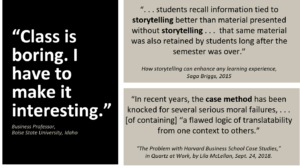Story Time for Business People
Did you know business is the most popular undergraduate major in the United States? Over a million students each year major in business. It’s popular because it’s practical—it enables students to develop immediately marketable skills in finance, accounting, marketing, public relations, and more. Those who major in business are making a solid educational investment.
Along with this popularity comes the reality that the tens of thousands of business educators who teach in the US often find that they need greater diversity of teaching materials; they need materials that capture and hold students’ attention while infusing deep and meaningful lessons. Current materials are okay, but more is needed.
- Business textbooks offer development of analytical skills but few actual executive experiences.
- Traditional case studies are short and provide opportunity to analyze a decision, but some educators claim they’re overly situational and static.
- Games and simulations are dynamic, entertaining, and useful, but often complex to set up; plus, educators say, the lessons don’t necessarily sink in.
With that in mind, a professor admitted to me at a trade show last year (pre-pandemic), “Class is boring. I have to make it interesting.” Indeed, I frequently hear this or a variation on it—professors need content that drives summary, synthesis, development of arguments, support for arguments using facts, reflection, pattern recognition, and curiosity by and among students. That need has increased with the pandemic.

At Braun Ink, we develop Braun Collection materials to help educators teach business using a contemporary, multi-format mix of entertainment and information. I created the Braun Collection as a complement to (not replacement for) the current mix of teaching materials (textbooks, traditional case studies, and games/simulations) used by educators. I wanted to offer educators content that is informative and entertaining, experiential and immersive, and complex enough in subject matter to represent the real business world, yet not so complex that students lose interest. In short, we mix traditional with new in a way that is unique and that works.
Our main pedagogical tools are a combination of storytelling, personal connection, adventure, and pictures.
- As far as storytelling goes, it’s a fact that “students recall material tied to storytelling better than material presented without storytelling . . . that same material was also retained by students long after the semester was over.” (quote from Saga Briggs, 2015)
- As far as personal connection goes, our stories are often personal narratives—memoirs and biographies—a type of storytelling that enables students to get know a business person as if that person were close to them; perhaps even a mentor. Our authors, who are executives and entrepreneurs, are willing and eager to do live video visits with students.
- As far as adventure goes, our books are action-packed and short, requiring only 2-3 hours to read. They are True Business Adventure Tales.
- As far as pictures go, every book comes with pictures in the center section, a short video that summarizes the story, and a highly visual presentation. This multi-media combination adds ample visual appeal. But, in addition to our books, we also offer short comic books and conversation cards called BizBios, both of which draw very heavily on visuals. We want students to have a stimulating visual experience.
Storytelling, connection, adventure, and images; it’s a powerful combination for educators who want to inform and entertain students.
Importantly, students gain vital knowledge and skills with these products. In reading an executive memoir or biography, students must take in and then summarize and synthesize complex information such as the many decisions made within an industry. They learn to develop arguments on important topics such as job creation, innovating, leading people, sales, and fundraising. They learn to support their arguments using facts from the text for and against the topics. And they learn to personally reflect, using facts from an adventure story and their own lives, on how their own careers may compare and contrast with the subjects of the books. This helps lessons marinate and sink in. Lastly, they learn to show curiosity about business leaders.
Synthesizing, summarizing, developing arguments, supporting their points, reflecting and showing curiosity — these are incredibly important competencies for business professionals, easily as important as knowing how to write code or balance a balance sheet.

Is it hard to add a book, comic book, or set of leadership conversation cards to a curriculum?
The answer is a resounding “No!” Educators can and do easily add these items to their syllabus, sort-of as a “punch up” of their main syllabus. To do so, they go to our website, review our products, and let us know what they want for their classroom. We then send them a link to provide to students, who order the product in soft or hard copy. We also provide the educator with a teaching pack. This includes—depending on the product–a teaching note with suggestions for classroom sessions, a short video to play for themselves or students or both, a reference sheet with key characters (like Cliff’s Notes), a presentation (if they want to use it), and the option to add the Live Video Visit by the author-executives of each book.
With Braun Collection products, educators can easily add entertainment and information to their general management, leadership, entrepreneurship, innovation, strategy, and finance syllabi. They can round out their students’ business education by helping infuse into the classroom a few often under-developed competencies like synthesis of complex information, deep discussion of meaty topics, development of structured arguments, reasoned articulation, and fact-based reflection. They can enable deeper connections to actual business leaders and the path of business leadership. They can allow immersion and exploration into a business life. They add a sense of pattern recognition around many decisions.
In short, we try to provide business educators with great business stories, which are the modern, effective pedagogical materials they need to do their jobs.
- Story & Biography Expertise